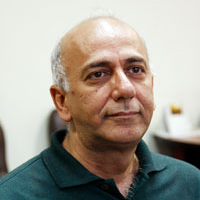Evaluation of the Ratio of Pulses of 6/8 Time Signature in Rengs of Dastgah Music of Iran (1906-1978)
Author(s):
Article Type:
Research/Original Article (دارای رتبه معتبر)
Abstract:
Rengs as a renowned type of Dastgah rhythmic music in Iran are often performed to finish a musical performance or to accompany of dance. These pieces have been usually recorded in written sources of music based on the normal 6/8 time signature. In the theory of western classic music, 6/8 time signature is a part of the combined rhythm with two pulses that each pulse can be divided into three parts. The equality of duration of both main pulses in every bar is one of the essential features of this western classic rhythm which has been accepted in notation of the Iranian contemporary theoretical music; however, examples of the recorded performances of this musical type from past hundred years onward show the flexible and unequal nature of the performance of Rengs in Dastgah music of Iran. By analyzing the audio samples recorded from Rengs, it is possible to obtain this precise numerical ratio that can change during the performance of a piece and sometimes return to equilibrium. Since fifty years ago, some musicians have expressed this difference in the notation and performance of 6/8 time signature and some of them have offered a number of suggestions for the unequal notation of the main pulses.Most researchers who have carefully studied this rhythm or cited to the results of earlier research believe that rhythm of Rengs is a different rhythm with two unequal pulses and have tried to find the difference between these two pulses. The highest concentration of votes is also on the (4 + 3) ratio. This study in addition to providing a review of different ideas of the classic musicians and contemporary musical theoreticians, by computational analysis of voice samples has extracted the exact temporal difference between the duration of the first and the second pulses. During the time period chosen for this research, which spans about seventy years (from the first period of Iranian music records in 1906 up to the samples in 1970s), there are many records of Reng`s performing on various media such as gramophone discs, magnetic reel and cassette tapes. In the selection of samples to measure the difference in pulses, it has been attempted to avoid selecting samples with equal pulses. After listening to more than 300 Rengs from different recording periods, has been selected samples in this study that show unequal pulses to find the maximum amount of flexibility in the rhythm. This study also shows that this flexible rhythm has the capability of performance of two equal pulses with 50% ratio up to unequal pulses with 62.5% and 37.5% ratios. There is always a duration increase in the first pulse and a decrease in the second pulse in this rhythm.Also it is noteworthy that in many old records of Rengs, the length ratio of the two major pulses can be equal, or be considerably taller and shorter and return to equality again in the same piece. In other words, the most flexible rhythm in Dastgah music is Reng that can exit the original pulses and return to equilibrium after a while.
Keywords:
Language:
Persian
Published:
Honar-Ha-Ye-Ziba: Honar-Ha-Ye Mosighi Va Namayeshi, Volume:26 Issue: 70, 2021
Pages:
47 to 54
magiran.com/p2323385
دانلود و مطالعه متن این مقاله با یکی از روشهای زیر امکان پذیر است:
اشتراک شخصی
با عضویت و پرداخت آنلاین حق اشتراک یکساله به مبلغ 1,390,000ريال میتوانید 70 عنوان مطلب دانلود کنید!
اشتراک سازمانی
به کتابخانه دانشگاه یا محل کار خود پیشنهاد کنید تا اشتراک سازمانی این پایگاه را برای دسترسی نامحدود همه کاربران به متن مطالب تهیه نمایند!
توجه!
- حق عضویت دریافتی صرف حمایت از نشریات عضو و نگهداری، تکمیل و توسعه مگیران میشود.
- پرداخت حق اشتراک و دانلود مقالات اجازه بازنشر آن در سایر رسانههای چاپی و دیجیتال را به کاربر نمیدهد.
In order to view content subscription is required
Personal subscription
Subscribe magiran.com for 70 € euros via PayPal and download 70 articles during a year.
Organization subscription
Please contact us to subscribe your university or library for unlimited access!



